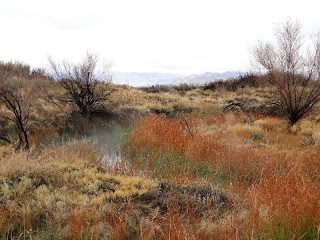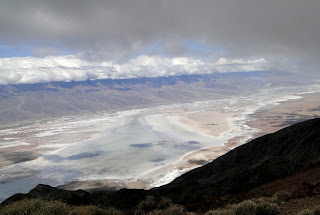We visited Salt Creek on the way back to Furnace Creek Ranch....
Salt Creek

Salt Creek runs in the valley and is home to the threatened and endangered pupfish. The fish must hurry to mate and raise their young before the creek drys up.

The boardwalk protects the habitat and is great for those with wheelchairs.
The male pup fish is beautifully colored with yellow and blue while in Ash Meadows Wildlife Refuge, the males were all blue. The male is aggressively defending his nesting territory against other males while he waits for a female.

The pupfish are only about 1-1/2 inch long. My husband bought me a t-shirt with all the species on it and where they were located because I liked them so much.
Furnace Creek Inn
On our last day, I treated my husband to breakfast at Furnace Creek Inn--the upscale resort.

The view from the lobby is quite nice.
Golden Canyon
On our way out of the park, we hiked Golden Canyon.
I recommend hiking this canyon late on a sunny day at sunset when the rocks would actually appear more golden than in the morning. We climbed up a rock face where I took this panoramic photo so we didn't have to hike the whole way.
Natural Bridge
As we hiked the short way to Natural Bridge, I turned around and took this photo of the wet valley floor and the western mountains.
You can tell how large the bridge is by the hikers in the background.
Ashford Mill Ruins
We drove south on Highway 190...
The Ashford Mill Ruins looked great against the blue sky ...
. . . and the distant mountains covered with snow.
Once, out of the park we headed east on 178 and south towards the remote China Ranch.
China Ranch

The China Ranch is a working farm which produces dates. Signs tell you where the date palms come from (California, Iraq, etc.). I have to admit I didn't care for the dates (for some reason my stomach doesn't tolerate them) but the gift shop was great with crafts from all over the world and at good prices.
Death Valley Notes
In July 1994, we had driven though Death Valley when the temperature reached 106 degrees, forcing us to turn off the air conditioning in the car---not pleasant. I never thought it would be a good park to visit until I saw Dawn's photos on her blog from December. So, our canceled and rescheduled winter trip was changed to Death Valley. Thanks Dawn! With our snowy winter, it was a great place to vacation and we saw other Virginians there with the same idea.
Hope you enjoyed my photos. Now, it's back to spring here in Virginia where the wildflower toothwort is budding.
Note: I posted 4 times about Death Valley. If you want to start at the beginning, click here.







































